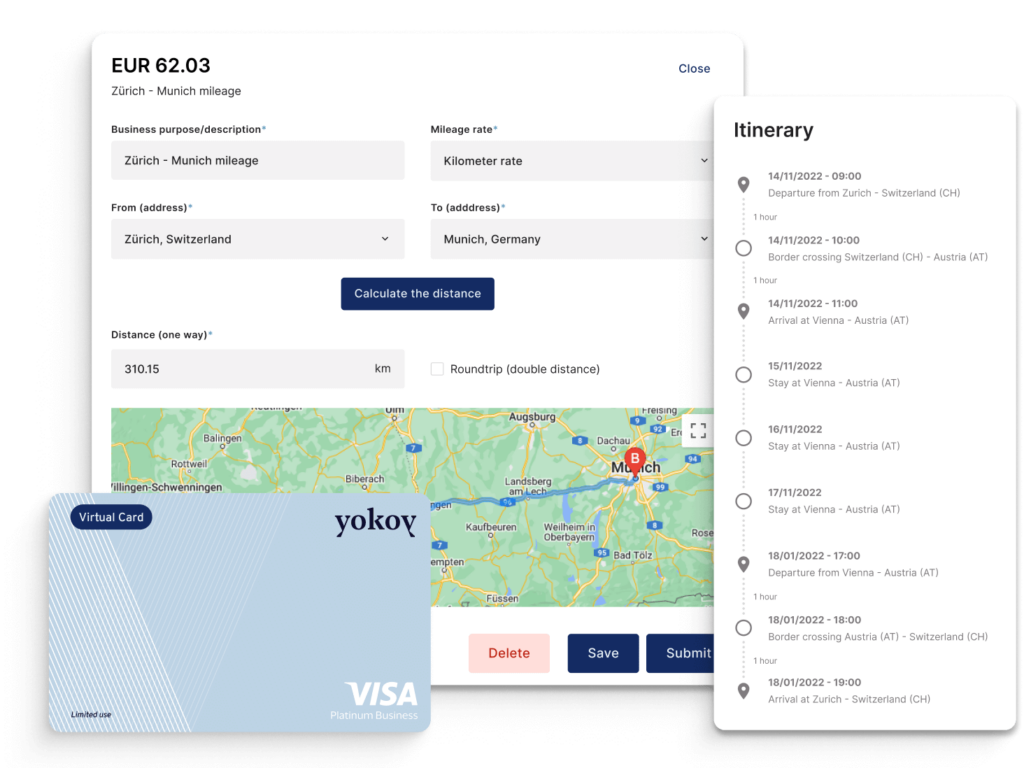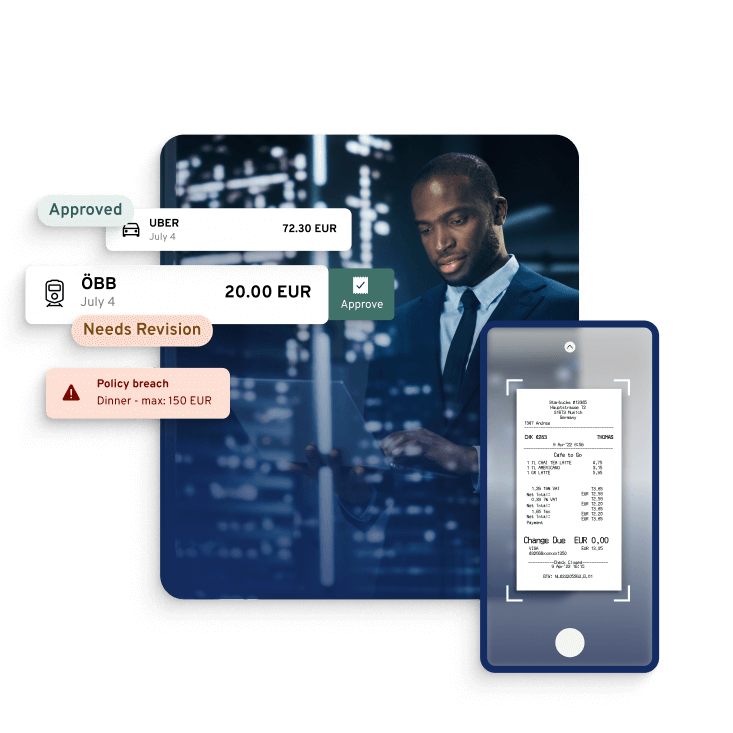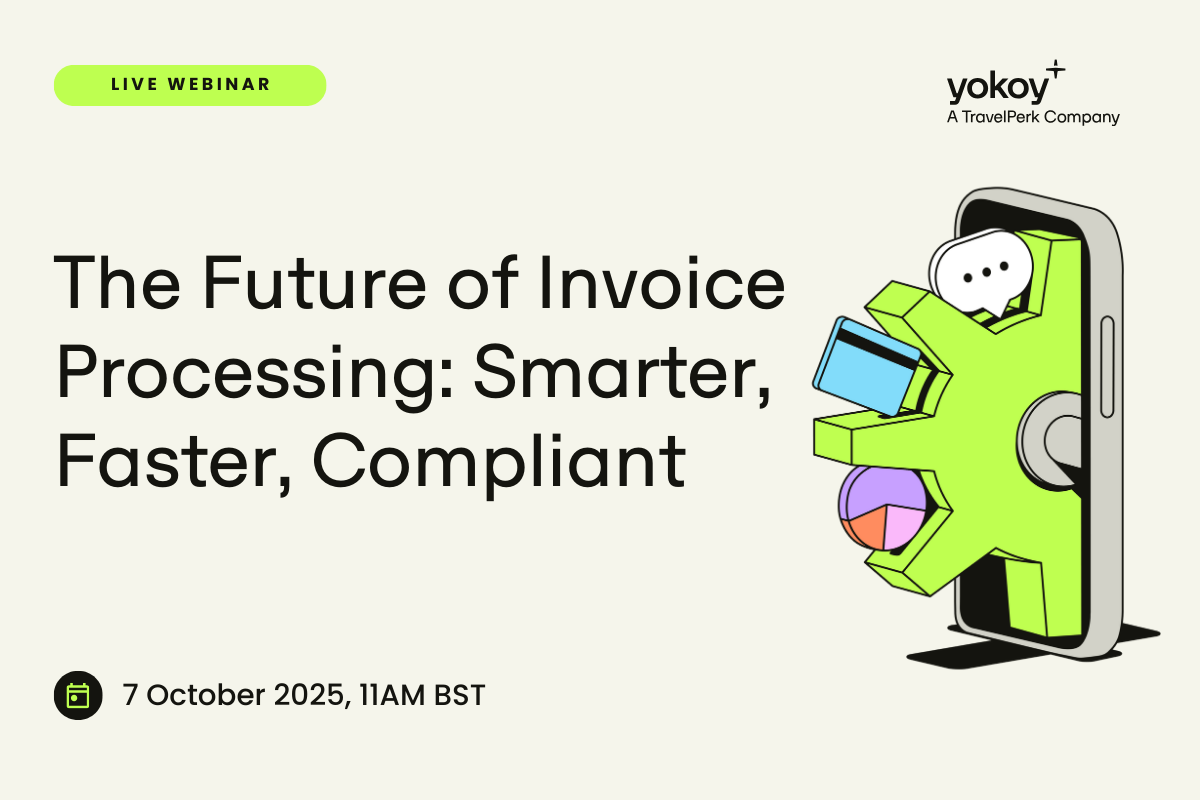Home / Understanding UK Per Diems: Guidelines and Best Practices
Understanding UK Per Diems: Guidelines and Best Practices
- Last updated:
- Blog

Travelling around the country for business can be very effective but stressful. When expense reports pile on the desks of finance teams, it becomes clear that a simpler solution would help streamline business spending. That’s where per diems come in handy, as they are tax-free, simplify the reimbursement process, and make corporate travel much easier.
What are per diems in the UK?
Sometimes also referred to as “Scale Rate Payments” per diems in the UK are daily allowances provided to employees to cover their expenses during business trips. These payments are intended to cover cost of living such as meals, accommodation, and incidental expenses without requiring employees to submit individual receipts for each expense.
HMRC (His Majesty’s Revenue and Customs) sets specific guidelines and rates for these per diem allowances, ensuring they are tax-free when used within the prescribed limits and for legitimate business purposes.
Implementing per diems can significantly simplify expense management for businesses. By providing a set daily allowance, companies can predict and control travel costs more effectively, which helps in budgeting and financial planning. Per diem benefits also reduce the administrative burden, as employees do not need to submit detailed receipts, and employers can streamline the reimbursement process. This saves time and reduces the potential for errors or disputes over expenses.
For employees, per diems offer clarity and predictability in covering their business travel expenses. Knowing the fixed amount they will receive daily allows them to plan their expenditures more efficiently. Additionally, per diems eliminate the hassle of collecting and submitting receipts, making the expense reimbursement quicker and less stressful. This flexibility contributes to higher employee satisfaction, as they feel more supported and trusted by their employer during business trips.
Per diem rates and more: HMRC guidelines summarised
In the UK, HMRC sets clear guidelines on the maximum tax-free amounts that can be reimbursed to employees through per diems without triggering additional reporting or tax implications. These allowance rates are designed to cover typical expenses during business travel, such as meal or mileage allowance. As long as the payments stay within HMRC’s prescribed limits and are used for legitimate business purposes, they do not need to pay tax and require no further documentation from the employer.
The standard rates set by HMRC are based on the duration of the employee’s travel and are intended to cover expenses like meals and minor expenses:
£5 for travel lasting more than 5 hours
£10 for travel lasting more than 10 hours
£25 for travel lasting more than 15 hours
These fixed rates allow employers to use scale rate payments to reimburse employees for subsistence expenses without the need for receipts, provided the payments are within pre-set limits.
HMRC provides specific benchmark rates for reimbursing employees’ travel expenses outside the UK, covering costs of international travel, such as accommodation and incidentals.
For companies and finance teams that find the standard HMRC travel rates insufficient to cover their employees’ expenses, they can negotiate per diem rates directly with HMRC. Once agreed, these bespoke rates can be applied across the company, offering greater flexibility while ensuring that all diem expenses remain within HMRC’s tax-free guidelines.
Yokoy Expense
Streamline your travel and expense management
Say goodbye to manual data entry, lost receipts, and complicated reimbursements. Yokoy handles everything from start to finish, for simple T&E management at any scale.

Per diems taxation and compliance
Per diems within the HMRC-prescribed limits are non-taxable, meaning employees can receive tax-free allowances. However, if an employer chooses to pay more, the excess amount is considered taxable income. This means that the additional portion will be subject to income tax and National Insurance contributions, and the employer must report it accordingly.
With a good documentation, maintaining accurate and thorough records of per diem payments, compliance with HMRC regulations is easy. A clear audit trail in case of any tax inquiries is key for this. Record-keeping protects both the employer and the employee from unexpected tax liabilities, ensures smooth financial operations and demonstrates that all payments align with HMRC guidelines.
Advantages and disadvantages of per diems
Several advantages come when using per diems, including simplifying expense management, providing predictability in travel costs, and reducing administrative burdens. Automation can also help maximise those advantages even more. However, per diems also have some disadvantages, such as potential dissatisfaction if the rates are too low and the risk of overspending if not managed properly.
Advantages of Per Diems
Per diems simplify financial management, cut paperwork, offer predictable travel costs, and boost employee satisfaction with their flexibility. These advantages make them a valuable tool for efficient business travel.
Simplified financial management: Per diems streamline the process of managing travel expenses by providing a fixed daily allowance. This eliminates the need for employees to submit individual receipts for every expense, making financial management more efficient for both employers and employees.
Reduced paperwork: Per diems significantly reduce the administrative burden. Employers no longer need to process numerous expense claims, and employees are relieved from the tedious task of collecting and submitting receipts, leading to a smoother reimbursement process.
Clear and predictable travel costs with real-time data: Per diems offer predictability in travel expenses, allowing businesses to budget more accurately. By using expense management software with real-time data, companies can monitor and control travel costs more effectively, ensuring that expenses remain within set limits.
Higher employee satisfaction thanks to more flexibility and autonomy: Per diems allow employees to manage their travel expenses as they see fit, enhancing their autonomy. This flexibility can lead to higher job satisfaction, as employees feel trusted and empowered to make decisions about their spending.
Disadvantages of Per Diems
Per diems have some downsides like limited spending control, the risk of misuse, and the potential for allowances to be seen as personal income. Effective expense management can mitigate these issues.
Limited control over how employees spend the allowance: One of the main drawbacks of per diems is that employers have less control over how the allowance is spent. Employees may choose to allocate their funds in ways that do not align with company expectations, potentially leading to inefficiencies or mismanagement of resources.
Potential for employees to treat the per diem as personal income: There is a risk that some employees might view the per diem as extra income rather than a reimbursement for travel expenses. This mindset can lead to prioritising personal gain over adhering to the intended use of the funds, possibly affecting the quality of work-related expenses.
Possibly leading to misuse: Without proper oversight, per diems can be misused, with employees spending the allowance on non-essential items or services. To mitigate this risk, companies can implement measures such as issuing company cards or setting clear guidelines on acceptable expenses.
Alternatives to per diems
One alternative to per diems is the “Round Sum Allowance,” a fixed monthly payment added to an employee’s salary to cover frequent travel expenses. Unlike per diems, which are calculated based on specific travel days, the Round Sum Allowance provides a consistent, predetermined amount each month, simplifying budgeting for both employers and employees.
This approach is particularly useful for employees who travel regularly, as it eliminates the need for daily calculations and reimbursements. However, this allowance may have different tax implications because it is typically treated as part of the employee’s taxable income. Another alternative is reimbursing actual expenses based on submitted receipts, offering more control over spending but increasing the administrative burden.
Companies may also use company credit cards with set limits, allowing precise tracking of expenses while giving employees flexibility. Each alternative has its advantages and drawbacks, depending on the company’s needs and the frequency of employee travel.
Yokoy Expense
Manage expenses effortlessly
Streamline your expense management, simplify expense reporting, and prevent fraud with Yokoy’s AI-driven expense management solution.

How to implement per diems with expense management software
To successfully implement per diems within your company, it’s crucial to clearly communicate the per diem policy to all employees. This ensures that everyone understands the allowances, limits, and expectations. Integrating expense management software that leverages AI and automation can significantly streamline the process, making it easier to manage expenses while ensuring compliance with HMRC guidelines.
Here’s how to make the most of expense management software for your per diem and travel management:
Automated per diem calculation
The software can automatically calculate per diems based on the travel duration and the HMRC-approved subsistence rates, eliminating manual calculations and reducing the risk of errors.
Corporate cards like Yokoy Platinum Visa Card
Issuing corporate cards linked to the expense management system allows for real-time tracking of spending. Cards like the Yokoy Platinum Visa Card can be configured to ensure that expenses stay within per diem limits, providing both control and convenience.
Automated travel allowances
The software can automatically apply travel allowances to an employee’s account based on their itinerary, ensuring that all per diems are distributed correctly and on time.
Timely reimbursements
With automated processes, reimbursements can be processed quickly and accurately, ensuring employees are reimbursed for any additional expenses without delay.
End-to-end travel integration
Integrating the software with your company’s travel booking systems allows for seamless management of all travel-related expenses, from flight bookings to hotel stays. This ensures that all costs are captured and managed within the same platform.
Custom expense forms
The software can be tailored to include custom expense forms that align with your company’s per diem policy and HMRC requirements. This ensures that all necessary information is captured and reported correctly.
Upload HMRC guidelines and company policies
Keeping HMRC guidelines and your company’s expense policies uploaded within the software allows for easy reference and ensures that all calculations and reimbursements comply with the latest regulations.
By leveraging these features, companies can implement per diems efficiently, ensuring compliance, reducing administrative burdens, and providing employees with a seamless and transparent expense management experience.
Next steps
Get in touch and find out how Yokoy’s spend management system can help you streamline your expenses!
In this article
Simplify your invoice management
Book a demoRelated content
If you enjoyed this article, you might find the resources below useful.


